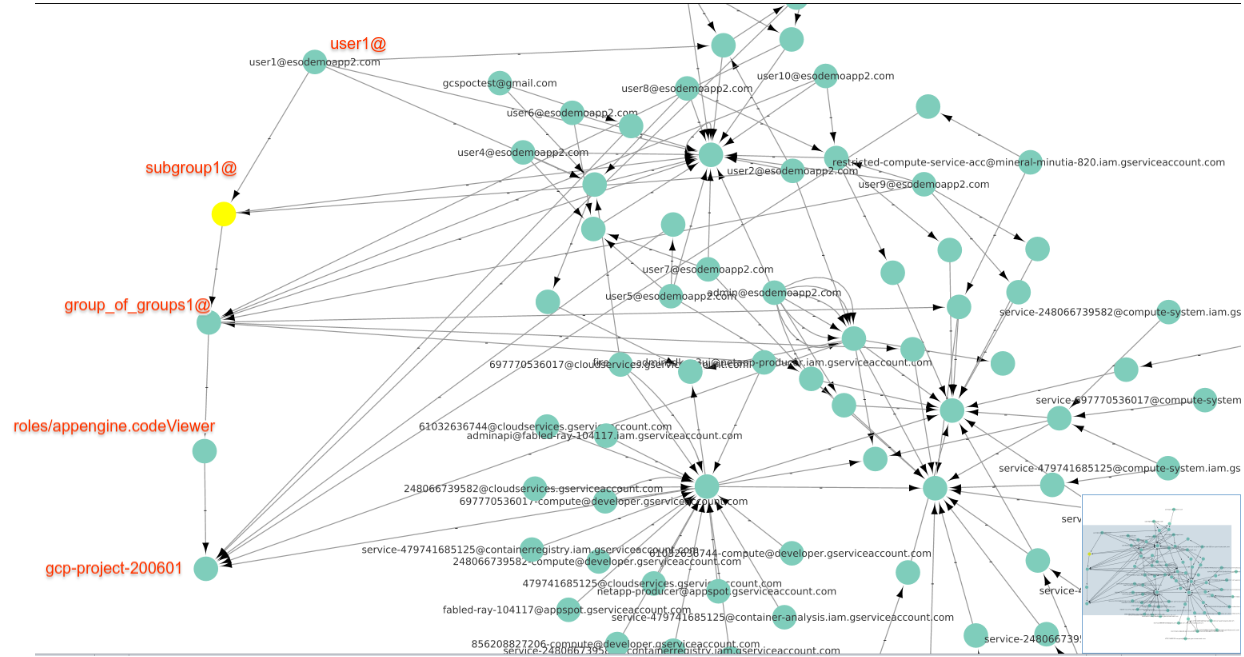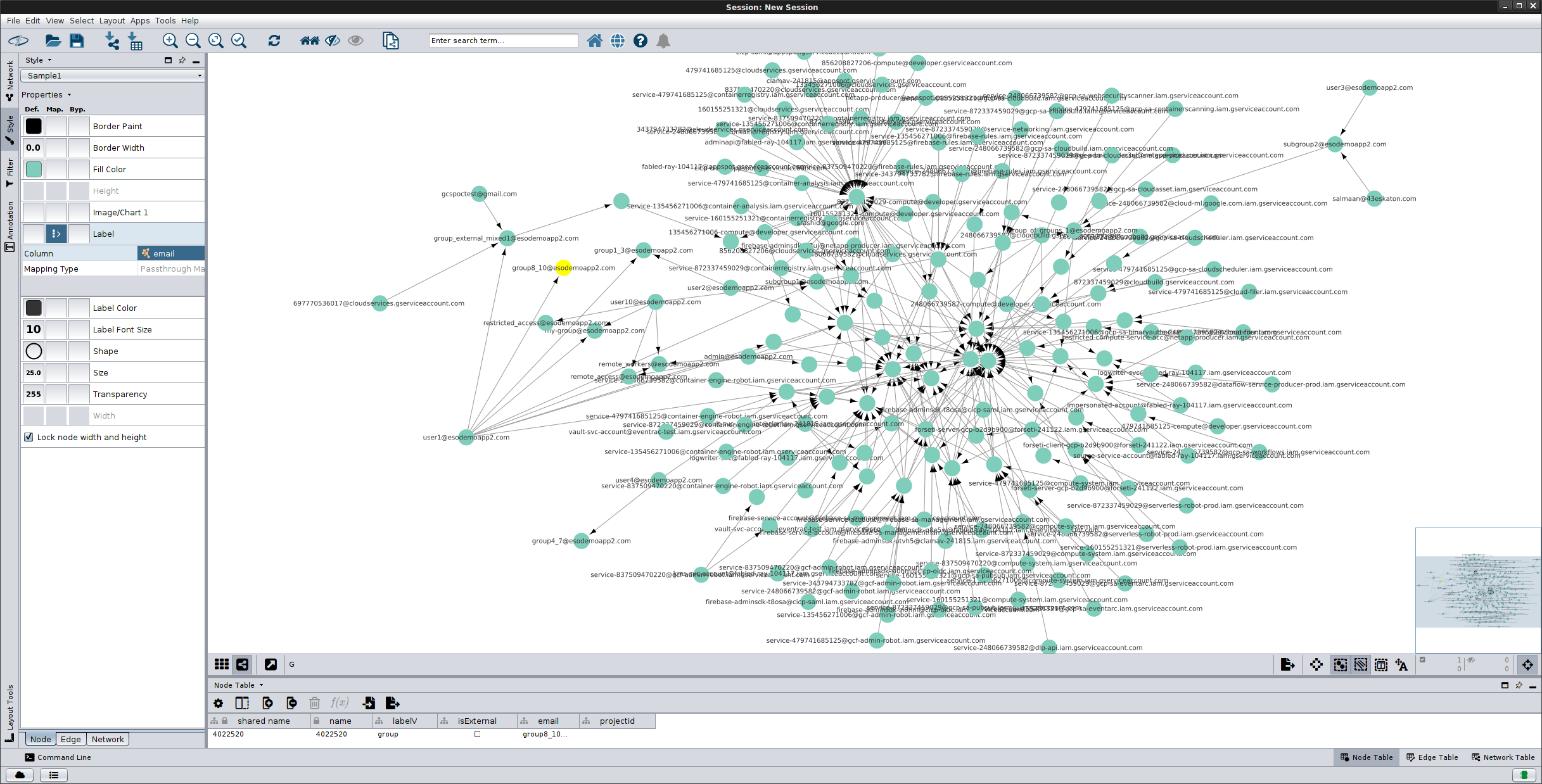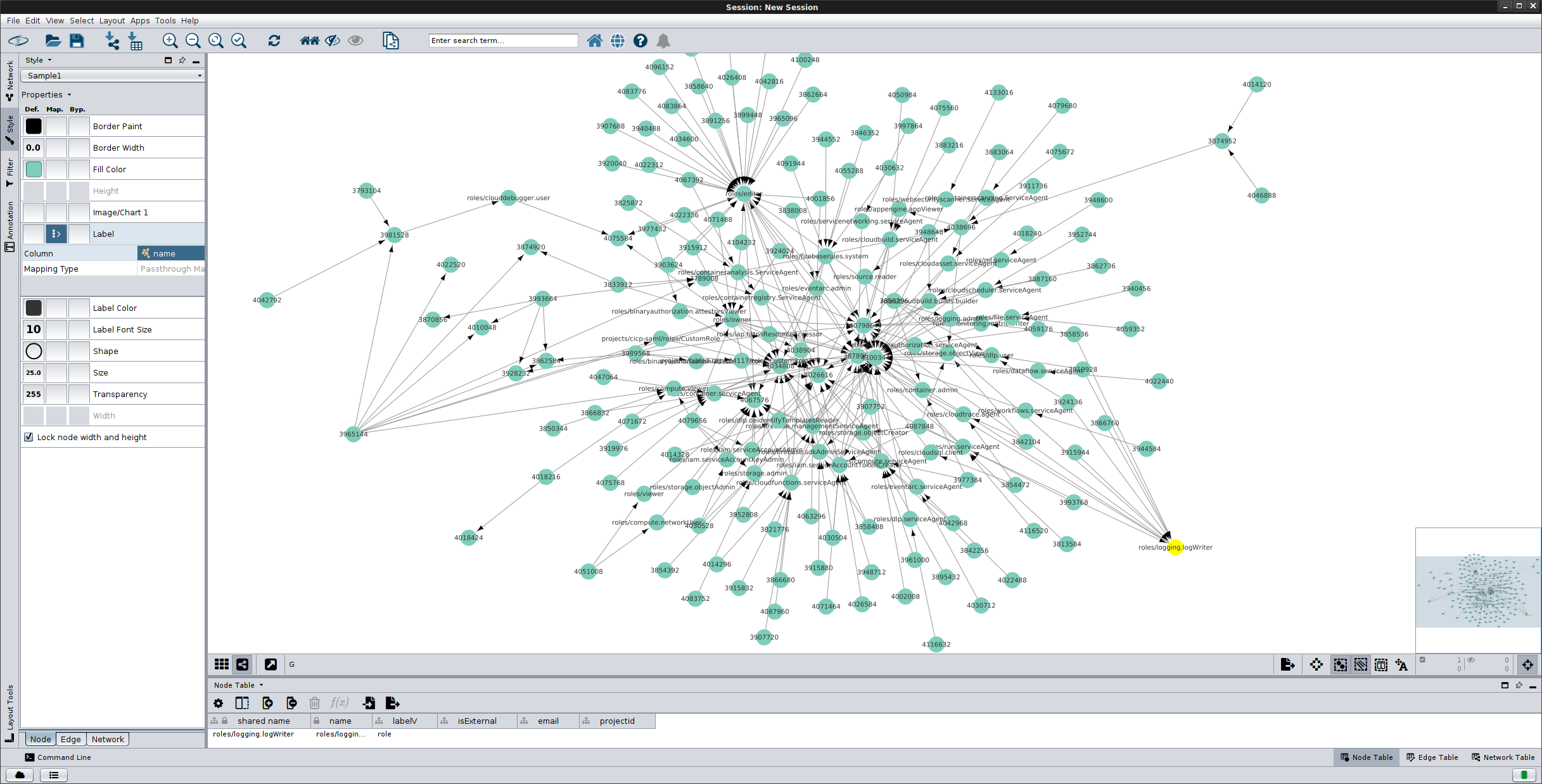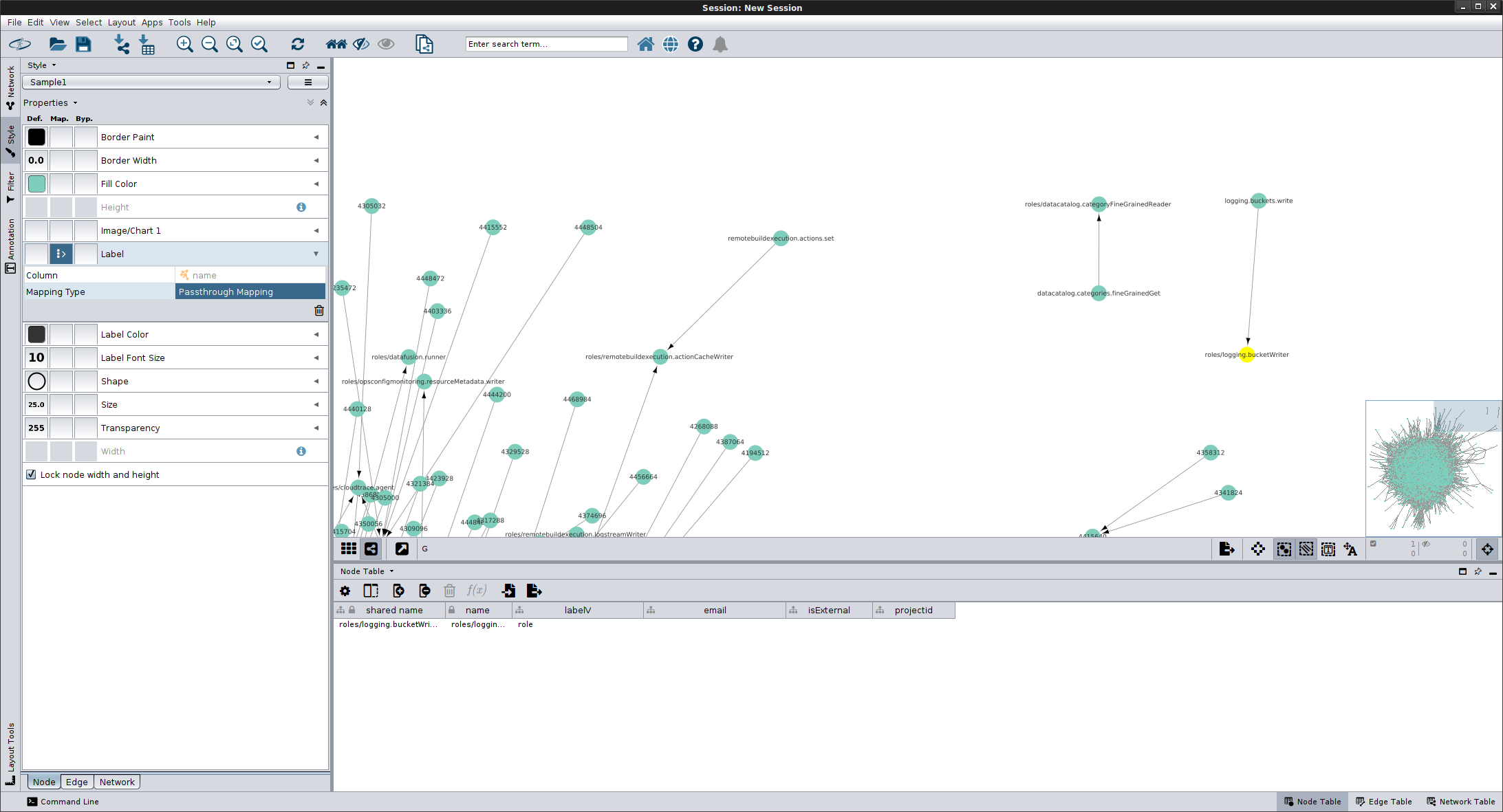Representing Gsuites and Google Cloud Org structure as a Graph Database
2018-08-28
12/13/25: NOTE: this was just a POC i ran, the graph map is incomplete (i haven’t been able to map the resources properly)…just use this for amusement
Sample procedure to import
- Gsuites Users-Groups
- Google Cloud IAM Policies (users,Roles,Resource)
- Google Cloud Projects
into a JanusGraph Database.
This allows sysadmins to easily ‘see’ how users, groups are structured across cloud org domain and can surface access privileges not readily visible (i.e, group of groups, external service accounts). Visualizing and having nested group structure also allows to easy see relationships between projects/users/roles/serviceAccounts.
For example, the following trivial section shows how a user has indirect access to a resource via nested groups:
Annotated flow that shows the links
user vertex user1@
-
has edge
into group vertexsubgroup1@(i.e., user is member of a group) -
group vertex
subgroup1@has edgeinto group vertexgroup_of_groups1@(i.e. group of groups) -
group vertex
group_of_groups1@has edgeinto role vertexroles/appengine.codeViewer(i.e, this role includes a group) -
Role vertex
roles/appengine.codeViewerhas edgeinto resource vertexgcp-project-200601(i.,e this resource/project has a role assigned to it) -
Adding IAM Permissions to Role Vertices
It would be useful to add the IAM permissions as multi-valued properties to each “Role” node However, as of
2/5/21, there are some issues i’ve come across in doing this that i’ve detailed at the end of the doc. Instead, as of2/13/21, i’ve just added the permission<->role maps in directly. This takes a LONG time to generate
You are free to alter the vertex->edge->vertex relationship in anyway you want; i just picked this simple scheme for starters.
SysAdmins can optionally query directly via gremlin command line for the same information.
WARNING: this is just a simple proof of concept: the script attached runs serially and the object hierarchy described below is very basic and likely incorrect!
You can find the source here
Representing Gsuites and Google Cloud Org structure as a Graph DatabaseThe intent here is to demonstrate how to load some sample data covering cloud org and gsuites structure into a graphDB
Schema
The schema used in this sample is pretty basic and indexes a few properties across users, groups, serviceAccounts project, IAM roles, and resources. However, there is boilerplate snippet that demonstrates iterating other resource types. For reference, see func getGCS(ctx context.Context)
The code snippet contained there iterates projects and for each bucket in that project, extracts the IAM bindings and members. The idea is to use that info to generate groovy snippets to emit to a file.
-
Note: the script and sample below does not cover cloud org, pubsub or GCE resource types. It only iterates and covers projects
- Users
g.addV('user').property(label, 'user').property('email', email).id().next()
- ServiceAccount
g.addV('serviceAccount').property(label, 'serviceAccount').property('email', email).id().next()
- Groups
g.addV('group').property(label, 'group').property('email', group_email).next()
- Projects
g.addV('project').property(label, 'project').property('projectId', projectId).id().next()
- Roles
g.addV('role').property(label, 'role').property('name', name).id().next()
Setup
The setup steps for this script primarily involves configuring a service account for both domain-wide-delegation and GCP cloud org access.
Configure Service Account for Domain Wide Delegation
1a. Create Service Account in Google Cloud Console (IAM & Admin > Service Accounts)
1b. Edit Service Account and Check “Enable G Suite Domain-wide Delegation”
1c) Find Oauth2 Client ID:
109909984808619572478
1d) Create API Client in Google Workspace Admin Console (Security > API Controls > Domain-wide Delegation)
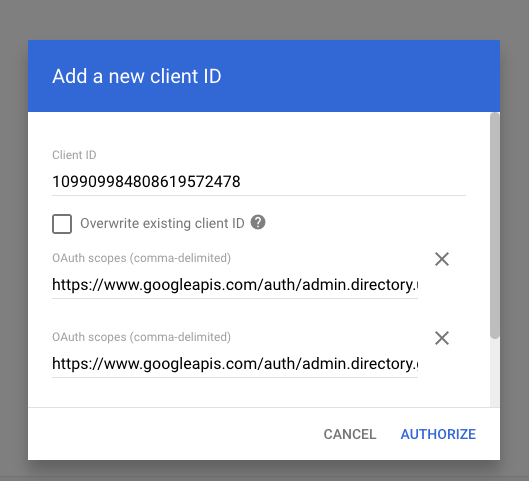
Specify the following OAuth scopes which gives access to view users and groups in your domain respectively:
https://www.googleapis.com/auth/admin.directory.user.readonlyhttps://www.googleapis.com/auth/admin.directory.group.readonly
For a list of scopes, see Admin Directory API
Confirm Client ID scopes by clicking ‘View details’:
Identify Gsuites CustomerID
You can derive it from your gsuites admin console here.
In my case its:
"customerId": "C023zw3x8"
alternatively,
$ gcloud organizations list
DISPLAY_NAME ID DIRECTORY_CUSTOMER_ID
esodemoapp2.com 673208786098 C023zw3x8
Configure Service Account for Cloud Org Access
Set cloud ORG policies to apply from the root org node to all resources in the tree:
1e) Provide Service Account Org-wide Access in Cloud Console (IAM & Admin > IAM)
- Security Reviewer
- Editor

1f) Generate and download a the service_account key
- Make sure the project where you are generating the key has the following APIs enabled:
Install JanusGraph
- Local Download and untar JanusGraph. I used version janusgraph-0.3.0-hadoop2
- Start JanusGraph with defaults (Cassandra, ElasticSearch local)
Note, you need java8
export JAVA_HOME=/path/to/jre1.8.0_211/
$ janusgraph-0.3.0-hadoop2/bin/janusgraph.sh start
Forking Cassandra...
Running `nodetool statusthrift`.. OK (returned exit status 0 and printed string "running").
Forking Elasticsearch...
Connecting to Elasticsearch (127.0.0.1:9200)..... OK (connected to 127.0.0.1:9200).
Forking Gremlin-Server...
Connecting to Gremlin-Server (127.0.0.1:8182)..... OK (connected to 127.0.0.1:8182).
Run gremlin.sh to connect.
- Connect via Gremlin
$ janusgraph-0.3.0-hadoop2/bin/gremlin.sh
\,,,/
(o o)
-----oOOo-(3)-oOOo-----
SLF4J: Class path contains multiple SLF4J bindings.
plugin activated: janusgraph.imports
plugin activated: tinkerpop.server
plugin activated: tinkerpop.gephi
plugin activated: tinkerpop.utilities
gremlin>
- Setup Gremlin local connection
:remote connect tinkerpop.server conf/remote.yaml session
:remote console
At this point, local scripts on local will get sent to the running gremlin server
Configure and Run ETL script
serviceAccountFile: path to the service account filesubject: the email/identity of a gsuites domain admin to representcx: Gsuites customerID
then on a system with go 1.11, run
go run main.go \
--serviceAccountFile=/path/to/svc_account.json \
--subject=admin@esodemoapp2.com \
--component=all \
--cx=C023zw3x8 \
--organization=673208786098 \
--logtostderr=1 -v 20
Note, if you want to also include a map of ALL permissions<->Roles, add the flag --includePermissions.
This setting will take a long to complete and will significantly increase the size of the graph.
NOTE: this utility will only sync ACTIVE projects
The parameters will iterate through all the gsuites user,groups as well as the projects and IAM memberships.
If you want to see more details, you can use log level 4 as shown here:
go run main.go --logtostderr=1 -v 4
(full groovy text output to stdout, use level 10)
If you want to iterate only a subcomponent, use the --component flag. For example, if you just want to iterate users, run
go run main.go --logtostderr=1 -v 4 --component users
The output of this run will generate several raw groovy files:
users.groovy: users to add to the mapgroups.groovy: groups and group members to addprojects.groovy: list of the projects to add to the graphroles.groovy: Roles and Permissionsserviceaccounts.groovy: list of the service aciam.groovy: IAM policy maps.
Note, init.groovy generates the index, schema, properties incase you need to define them. At the moment the config defines a no-op property
mgmt = graph.openManagement()
p = mgmt.getPropertyKey("noop")
if (p == null) {
mgmt.makePropertyKey('noop').dataType(String.class).cardinality(org.janusgraph.core.Cardinality.LIST).make()
mgmt.commit()
}
p = mgmt.getPropertyKey('noop')
graph.tx().rollback()
if (m.getGraphIndex('byNoopComposite') == false) {
mgmt = graph.openManagement()
mgmt.buildIndex('byNoopComposite', Vertex.class).addKey(p).buildCompositeIndex()
mgmt.commit()
// ManagementSystem.awaitGraphIndexStatus(graph, 'byNoopComposite').call()
}
Use the init.groovy file to define properties, verticies, constraints and index values
Combine all the files:
cat init.groovy users.groovy serviceaccounts.groovy groups.groovy projects.groovy iam.groovy roles.groovy > all.groovy
Then make sure Janusgraph and gremlin are both running before loading each file.
in the gremlin console, run
gremlin> :load /path/to/all.groovy
Note, if you enabled --includePermissions, this load may take upto an hour+, right. Even if not, it may take sometime (like an hour+)…you’ll see progress though…get a coffee.
if its all configured, you should see an output displaying the vertices and edges that were created. (see section below about visualizing the graph)
References
- https://docs.janusgraph.org/latest/getting-started.html
- gremlin-server
- https://github.com/bricaud/graphexp
- https://medium.com/@BGuigal/janusgraph-python-9e8d6988c36c
- https://github.com/apache/tinkerpop/tree/master/gremlin-python/
- https://www.compose.com/articles/graph-101-traversing-and-querying-janusgraph-using-gremlin/
Gremlin References
Drop All Vertices and Edges
- On Gremlin Console
g.V().drop()
g.E().drop()
For gremlin-python, simply append suffix commands to submit the request to Gremlin-Server, eg: .next(), .iterate():
g.V().drop().iterate()
g.E().drop().iterate()
Sample query to retrieve a user and its edges:
- Outbound Edges from a Vertex:
gremlin> g.V().hasLabel('user').has('email', 'user1@esodemoapp2.com').outE()
==>e[1d0d-1eqw-4etx-iyw][65768-in->24584]
==>e[1an1-1eqw-4etx-1o3s][65768-in->77896]
==>e[1925-1eqw-4etx-1o88][65768-in->78056]
==>e[1btp-1eqw-4etx-oej80][65768-in->40988880]
- Connected Vertices from a Vertex:
gremlin> g.V().hasLabel('user').has('email', 'user1@esodemoapp2.com').out().valueMap()
==>{gid=[subgroup1@esodemoapp2.com], isExternal=[false]}
==>{gid=[group1_3@esodemoapp2.com], isExternal=[false]}
==>{gid=[all_users_group@esodemoapp2.com], isExternal=[false]}
==>{gid=[group_external_mixed1@esodemoapp2.com], isExternal=[false]}
Visualizing the Graph
There are several ways to visualize the generated graph:
Neo4J and OrientDB
I havne’t tried it but you should be able to export the graph to GraphML and then import into Neo4J. See:
To export the graph to graphML, see the section below about CytoScape
There are probably other ways to export from janusgrahph/gremlin and import…
Cytoscape
- Export graph to GraphML file:
gremlin> sg = g.V().outE().subgraph('sg').cap('sg').next()
==>tinkergraph[vertices:183 edges:290]
If you exported the role<->permission (eg, used export --includePermissions), then the graph is much, much larger
gremlin> sg = g.V().outE().subgraph('sg').cap('sg').next()
==>tinkergraph[vertices:4755 edges:33834]
Finally export the graph:
gremlin> sg.io(IoCore.graphml()).writeGraph("/tmp/mygraph.xml")
==>null
- Import GraphML to Cytoscape
on Cytoscape, File->Import->Network->File, Select GraphMLFile the /tmp/mygraph.xml
Upon import you should see the Cytosscape rendering:
The graph below uses the defaults included in this repo which covers: users, groups, serviceAccounts, all roles, projects, GCS buckets
roles that are in use
However, if you used, ``–includePermissions` then the graph starts to look like the corona virus
If you zoom in, you can see some details after you enable the appropriate filters
(i don’t know how to use cytoscape at all so thats the limit of my usability: zoom/unzoom with labels)
graphexp
git clone https://github.com/bricaud/graphexp.git
cd graphexp
firefox index.html
I highly doubt you can render any graph that uses --includePermissions using graphep…
Gephi
Export to Gephi for Streaming
gremlin> :remote connect tinkerpop.gephi
==>Connection to Gephi - http://localhost:8080/workspace1 with stepDelay:1000, startRGBColor:[0.0, 1.0, 0.5], colorToFade:g, colorFadeRate:0.7, startSize:10.0,sizeDecrementRate:0.33
gremlin> :remote list
==>0 - Gremlin Server - [localhost/127.0.0.1:8182]-[1f4452c0-4580-4ecf-9648-bc668c4ee68e]
==>*1 - Gephi - [workspace1]
Permissions as Role Properties
One option that is not implemented in this branch (but is in earlier commits), is to attach the permissions to roles as properties.
For example
if (g.V().hasLabel('role').has('name', 'roles/appengine.appViewer').has('projectid', 'netapp-producer').hasNext() == false) {
v = graph.addVertex('role')
v.property('name', 'roles/appengine.appViewer')
v.property('projectid', 'netapp-producer')
v.property('permissions', 'appengine.applications.get'); v.property('permissions', 'appengine.instances.get'); v.property('permissions', 'appengine.instances.list'); v.property('permissions', 'appengine.operations.get'); v.property('permissions', 'appengine.operations.list'); v.property('permissions', 'appengine.ser
vices.get'); v.property('permissions', 'appengine.services.list'); v.property('permissions', 'appengine.versions.get'); v.property('permissions', 'appengine.versions.list'); v.property('permissions', 'resourcemanager.projects.get'); v.property('permissions', 'resourcemanager.projects.list');
}
We can do that since we defined the permissions property as a LIST in init.groovy:
mgmt = graph.openManagement()
p = mgmt.getPropertyKey("permissions")
if (p == null) {
mgmt.makePropertyKey('permissions').dataType(String.class).cardinality(org.janusgraph.core.Cardinality.LIST).make()
mgmt.commit()
}
However, i ran into some issues issues:
-
The current application writes the groovy files to disk and imports it via the admin gremlin CLI. This ofcourse isn’t the right way to do this but i don’t know this tech very well. Loading a vary large permission set (which can number 1000s for things like
role/owner) will cause a socket timeout in gremlin cli. This is certainly a solvable problem but i haven’t invested the time into this feature -
GraphML export format does not suport multi-valued properties. Well…thats as far as i know…if you try to export the graph, you’ll see
gremlin> sg.io(IoCore.graphml()).writeGraph("/tmp/mygraph.xml") Multiple properties exist for the provided key, use Vertex.properties(permissionsI do know you can GraphSON format does support it but i don’t know of a utility that will render it
mapper = GraphSONMapper.build().addCustomModule(org.janusgraph.graphdb.tinkerpop.io.graphson.JanusGraphSONModuleV2d0.getInstance()).create()
writer = GraphSONWriter.build().mapper(mapper).create()
file = new FileOutputStream("/tmp/mygraph.json")
writer.writeGraph(file, sg)
So instead, i just made the permissions as their own nodes.
This site supports webmentions. Send me a mention via this form.
